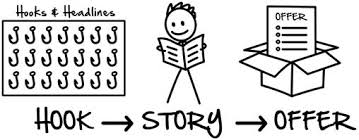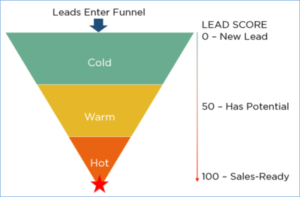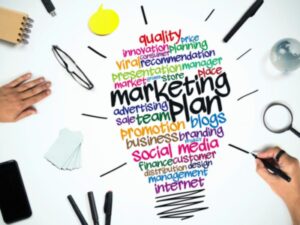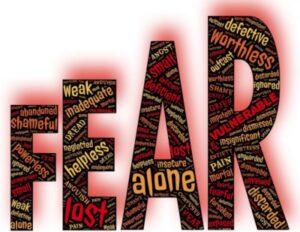If you’ve been around marketing for any period of time you may have heard of “hook, story, offer.”
It’s widely talked about these days in marketing circles, yet many marketers have never heard of it. Some people have heard of it but don’t fully understand it or why it works.
I first came across the idea when listening to one of Russell Brunson’s podcasts, and later again in his book “Traffic Secrets” and it was a kind of “aha” moment for me – I finally had an easy framework for structuring my marketing campaigns and sales pages!
Click here to get a free copy of Traffic Secrets by Russell Brunson (you only pay for shipping).
In this post, I break down the hook, story, offer framework, and go through each part explaining why and how it works. By the time you finish this post, you’ll have a great overview and be able to start applying the framework to your marketing.
What is hook, story, offer?
Hook, Story, Offer is a framework for selling. The framework outlines three stages you can take someone through in order to grab their attention and turn them from a prospect to a customer.
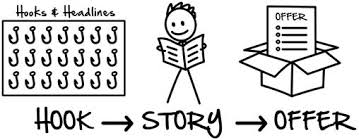
It offers a simple way to attract prospects, educate them about your product or service, and get them to take action on your offer.
The first stage is to hook your prospect. Once you have their attention you can tell them a story about your product and how it will give them the results they want. Lastly, you present them with your offer.
Where can you use the framework?
It can be applied to Google Ads, Facebook ads, sales letters, video sales letters, funnels, emails, webinars, live events, etc. It is applicable in all situations and to all products and services if you know how to use it properly. It provides you with a great framework for how to structure your marketing and sales messages for maximum results.
Let’s go through each part in detail.
The hook
A hook is what you use to grab your prospect’s attention. It should make them stop what they’re doing long enough to pay attention to what you’re saying. The hook grabs their attention so you can tell them a story.
In order to do this a good hook should arouse curiosity and make your prospect eager to read/watch or hear the rest of your story. Hooks can take various forms. They can be headlines, they can email subject lines, pictures that grab your attention whilst scrolling through social media etc.
Regardless of what form they take – a hook is anything that grabs your prospect’s attention and arouses enough curiosity for them to want to keep listening to what you have to say.
An effective marketing hook should make people crave more information. A hook isn’t about selling, or converting prospects….that part comes later. Nor is a hook a USP (unique selling point) of your product or service.
It’s more of a benefit or result statement that your prospect wants. A USP is what makes your product or service unique from your competition. It’s what makes you different. You can think of a hook as a mini, ultra-short story that creates curiosity about the benefits that your product or service offers as a result of a USP.
It’s a hidden angle or slant that you can use to arouse curiosity among your target market.
Examples of Hooks vs USPs:
- Hook: “How a wheelchair bound retired war veteran helped me to get in the best shape of my life”
- USP: This course could contain special exercises never seen before or contained anywhere else
- Hook: “How to improve your pickup skills in 7 days and get more dates than you thought possible”
- USP: You get 30 proven, tested, never revealed before pickup methods from the worlds best pickup artist
Can you see how the hooks are different from the USPs? A hook is more of a benefit, whereas a USP is a feature.
Hooks are mainly about benefits – what your customer gets from using your product or service. Great marketing hooks tease your prospect with the benefit or result they are after. Hooks that arouse curiosity normally allude to how they can obtain this benefit within a certain timeframe, or with minimal effort.
How to write good marketing hooks
The purpose of a good hook is to arouse curiosity. You want to get your prospect curious about your product and how it can work for them.
Curiosity-arousing hooks normally allude to how you can obtain this benefit within a certain timeframe or with minimal effort.
There are two formulas for writing hooks I learned from Jim Edward’s great book Copywriting Secrets.
1. “Unlikely character plus timing plus results”
Examples:
“Former cleaner shows you how to achieve financial freedom on the stock market in one weekend”
“Write and publish your own bestselling book on Amazon in under 30 days, even if you’ve never written before!”
2. “Result plus timing minus pain”
Examples:
“Lose stubborn belly fat in 27 days without dieting or having to do any crazy exercise regime”
“Easily boost your confidence in 7 days just by listening to this mp3, so you’ll be able to approach the opposite sex and pickup more dates”
These frameworks are effective because they play to two things that most people want:
- They want fast results
- They want results without much effort
Now you understand what a hook is, let’s get to the story…
The story
Once you have grabbed your prospect’s attention and aroused their curiosity through your hook its time to tell them your story. Your story should make your prospects connect with you, your product, or your brand more deeply. It should touch them on an emotional level.
The purpose of your story is twofold:
- It should build a connection with you and/or your brand.
The story should establish this connection so that even if your prospect doesn’t buy from you straightaway, they have that connection with you/your brand which will enable them to follow/like/subscribe to you and become a paying customer down the line.
The story builds the initial connection which you can develop further through continued marketing and communication efforts.
- Your story should demonstrate how your product/service gives your target audience the result they are seeking.
This will increase your prospect’s desire to have your product/service and increase the value of the offer you will make.
Storytelling is one of the most effective ways to sell. They are effective because the actual selling takes place within the context of a story, rather than using overt in-your-face selling.
When you create a story around your product, brand, or ideal customer you can create a better connection with your target audience. This is more effective than if you just start screaming marketing and sales messages at them without having first established that rapport.
Stories build rapport, they establish trust and likability. They are also a great vehicle for sharing messages. Your story should center around your attractive character.
What is an attractive character?
An attractive character is like your customer avatar. They represent your ideal customer or target market. The attractive character can be real or can be fictional.
If you have a real customer story to share that’s great, if not you can create one around your ideal customer. It’s important to really understand your ideal customer in order to make story-selling work for you.
You should know what their pain points and problems are. You should know what result they are seeking, and what obstacles lie in the way of them achieving that result.
When you know these things you can create your attractive character or hero of the story so that they possess these same qualities, and have the same problems your target audience has. This makes your audience relate to your attractive character. Your audience should be able to see themselves as the attractive character.
They should relate to the attractive character’s problems and struggles because they are the same problems and struggles they are experiencing. When you have your attractive character you need to know the best way to structure your story so that it all fits together.
Click here to learn more about the attractive character
How do you structure your story?
Your story should consist of 3 parts.
1. It should detail where your attractive character was before they discovered your product or service.
This is where most of your ideal customers and prospects are now. They most likely haven’t heard of you or your brand, product, or service yet. They are in pain and in want of a result. They are desperate to find the solution to your problem.
The first part of your story should detail your attractive character going through this phase of struggling with the problem.
- What are your prospects feeling?
- What sort of pain are they in?
- How does this situation make them feel?
Maybe they feel helpless. Perhaps they feel like they have lost hope. These emotions and feelings should be mirrored within your attractive character. This forms the first part of the story.
2. The second part of the story is the epiphany
This is where your character discovers your product or service as the solution they have been seeking. This is the turning point for them – where hope is rekindled and where your character can see some light at the end of the tunnel.
In this part of the story, you should outline how they discovered and started using your product. You can highlight the discovery process, and also any doubts they may have been experiencing towards your product.
Ultimately your attractive character should overcome those doubts and decide to give your product a try and put it to the test.
3. The third part of the story is about the result
The last part of the story should outline how the hero of your story was able to achieve the results they were after by using your product or service.
This part should highlight how your character’s life was changed by achieving this result, and how it made them feel.
Use plenty of emotional words to describe how achieving the desired result made your character feel. Asking yourself the following question can help with this process:
- How did it positively impact their life?
- What changes did it bring to their social life?
- Has it had an impact on their finances or economic circumstances?
- How has it positively affected their physical health or mental and emotional well-being?
These are the sort of questions you should be asking yourself when writing this part of the story. Of course, the answers will differ depending on the nature of your product or service and the results it delivers.
This is the part of the story that does the actual “selling”. When your prospects read your story they should be able to relate to the character. They should identify with their situation and problem.
When your character discovers the solution (your product) and uses it to achieve the desired result, your prospect should be able to imagine themselves feeling the emotions your character is feeling.
By using words that create strong visual imagery and elicit emotional responses you can make your prospects feel what your attractive character is feeling. This works because your prospects want to experience what they are feeling.
They crave that result. Like your attractive character, they too have been looking for a solution to their problem. They want your attractive character to succeed in their journey because they too want that result for themselves.
When your character fulfills their goal or gets the result they are after by using your product or service, your prospect should feel those same emotions. They are after the same result and the same winning feeling your attractive character is experiencing.
The story creates the desire for your product or service. This is what makes them want to buy. Once prospects have read your story they are now ready for your offer.
The offer
You have grabbed your prospect’s attention through your hook. You’ve built a connection with them and created a desire for your product or service through your story. It’s now time to make them an offer.
Ideally, your offer should be related to them buying your product or service or making some sort of purchase. But it doesn’t always have to be. It could be an offer for a free trial, or for a free e-book or report. It could be something you’ll give them if they take some sort of action such as subscribing to your list or channel, sharing a video, or liking a post.
Whatever it is, it should be attractive enough for them to take action on it.
Tweak and test
So now you have an excellent overview of the Hook, Story, Offer framework.
If your ads aren’t driving enough prospects or generating enough clicks then you need to re-work your hook. If you find that your prospects are reading your story but they’re not acting on your offer, it usually means you need to improve the story to increase the perceived value of your offer, or you may have to improve your offer.
Most marketing campaign success or failure can be attributed to one of these three elements of the framework.
Analyse which part is underperforming and make it better. Test different hooks, re-write stories, and try and improve your offers. By tweaking one you may find your overall results dramatically increase.

